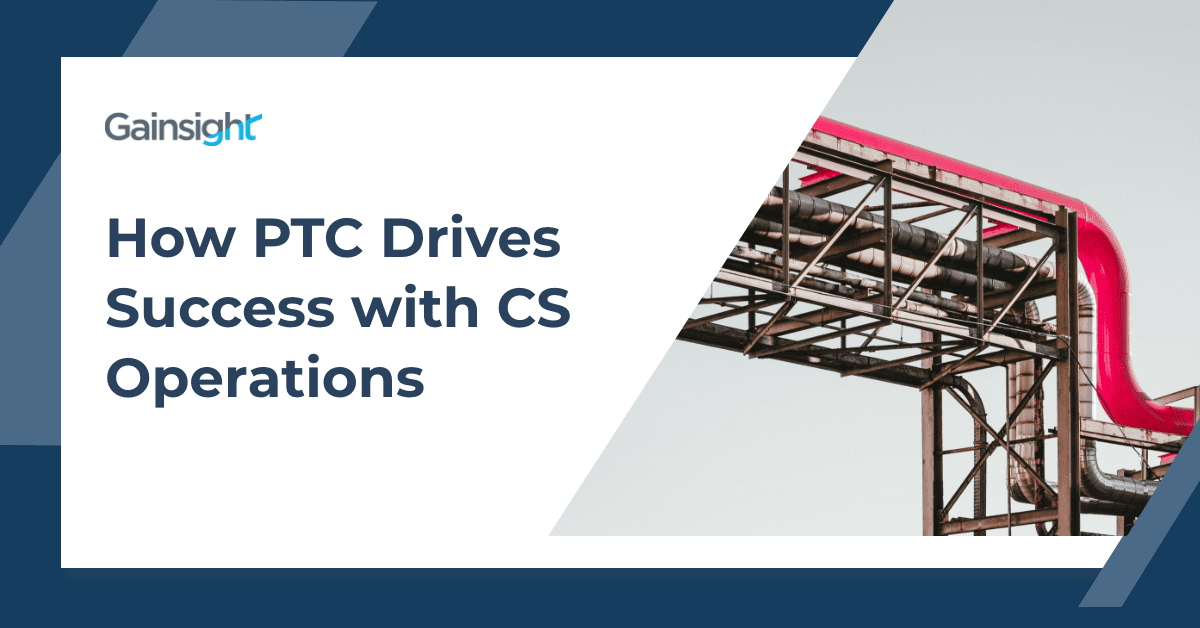Top customer success teams share a growing theme: their own operations team.
I first became a CS Ops leader in 2014, and I’ve seen time after time the value of the software, enablement, templates, data, and more that I’ve helped provide. What’s the first question I ask any CS Ops leader, though? “What do you do?” CS Ops can feel gratingly vague to understand since it lacks the long history and norms of our go-to-market cousins in Sales Ops and Marketing Ops. To help crack that code for you, we’re interviewing a few rockstar CS Ops leaders to learn what they do, how they’re organized, and how they enable their customer success teams to shine and achieve.
The CS Ops leaders at PTC have refined the art and science of translating management’s goals into real, tactical improvements. In large part, they credit their success to their deep understanding of leaders’ strategy and the desired business outcomes. Armed with that information, they can craft the outcomes that customers will need to achieve for their business to move in that direction. They can then connect the dots to the process improvements and technology to get the job done and the right people and teams to help make those changes.
Let’s start with our starring characters. PTC placed CS Ops leadership in the hands of Emmanuel “Manny” Govignon (Vice President of Operations, Customer Success Management) and Scott Trimmer (Business Relationship Manager on the IT team). Manny focuses on process transformation, often partnering with teams like HR and Finance. As part of the IT team, Scott brings expertise and best practices to managing the team’s workflows. Manny and Scott support the entire customer success group, including CSMs, technical account managers, escalation management, customer marketing, and more. (Scott also supports other departments for IT.) They work tightly together to work in tandem without duplicating effort.
It seems that the rarest and unique strengths of a CS Ops team come from the uncommon challenges they’ve needed to solve. With Manny and Scott in separate teams and supporting so many leaders between them, governance has become something of a superpower in their toolkit. They point to it as a key driver of their success and consider it one of their greatest lessons learned and areas of advice to offer.
Governance has some straightforward value, such as agreeing on a roadmap, alerting stakeholders of upcoming changes, and surfacing redundancies. PTC has discovered something more: it empowers Manny and Scott to instantly distinguish the one-off requests or a single person’s opinion from the input that supports and drives forward key strategic transformations in the business. If you’ve ever worked in CS Ops, you’ve wrestled an untidy mess of to-dos, widely varied in size, importance, urgency, topic, and so on. Plus, the scope of a to-do tends to expand and shift, and that doesn’t necessarily stop when it’s “done.” What could be more valuable than a clear north star for prioritization? How indispensable is a vision for the most meaningful scope of a project? Manny calls it “Governance Balance”: committing the needed time to projects that will support key strategic plays that the company is making and thoughtfully investing your remaining time in the team’s ad-hoc, tactical needs.
So how does PTC do it? Their prescription for governance has these ingredients:
- It is CS Ops’ responsibility to make governance a reality
- Governance meetings occur with unflinching consistency:
- Customer Success Leadership Team QBR: 1 per quarter. Align on needs and priorities.
- Vendor-specific Steering Committee for key vendor(s): 1 per quarter. Review value delivered, align on the roadmap, and discuss roadblocks/risks/issues.
- CS Leader 1-on-1s: 1 per month. Stay in tune with organizational priorities and ensure the roadmap aligns with leadership direction.
- CS Cross-Functional Team Alignment (1 to 2 levels below the CS Leaders): 1 per quarter. Discuss priorities across all CS teams to identify operational implications, review the existing list of needs, validate that they haven’t changed, and prioritize them.
- Conversations cover the team’s complete gamut of processes and tools.
- Begin with stakeholders’ intended business outcomes; all the impacts on people, process, and tools flow from there.
- For example, Manny and Scott say that this was a misstep when they first implemented Gainsight. They built a system that delivered the things the business asked for, instead of a system that produced outcomes that management and CSMs needed.
- Executive sponsors find the discussions meaningful and valuable moments to craft the plans to collaboratively turn their vision into reality; they recognize the importance of the conversations and care about the outcomes.
- Scott funnels key information and decisions into IT’s governance cadence (for example, he presented to IT leadership about PTC’s upgrade from Gainsight Salesforce Edition to Gainsight NXT)
- Include key vendors, whose industry expertise Manny says provide a “voice of possibilities” and “ballast towards best practices” (for PTC, Gainsight is one such vendor)
- Instill a “growth mindset” philosophy, helping leaders to understand that CS Ops projects are often “ongoing, living, developing, and maturing,” not set-it-and-forget-it, since that approach transforms the way your stakeholders will interact with you and your work products
You may already be squirming with envy of PTC’s governance, but just wait to hear the direction they’re evolving next.
How do you measure the business outcomes of a CS Ops project? (Not of customer success in general, but a specific ops project.)
An excellent first step is to baseline how well the CS team is operating. Manny and Scott looked to their Support team for inspiration since Support needs to scrutinize their operations daily to adhere to contractual SLAs and certification requirements. Adapting the principles to customer success, the CS leaders now have dashboards that show “Service Realization” metrics (such as time to assign a CSM to a new customer or time to complete onboarding) and “Services Enablers” metrics (such as enablement completed and account ratios).
PTC hopes to extend even further, though. Operational work is designed to help customers achieve better outcomes, leading to better renewal, expansion, advocacy, or other strategic outcomes for the business. It’s a tall order to tell that story in a cohesive, data-driven way. PTC has already taken one step to elevate NPS, as a measure of customer experience, to the same level as the dollar-based metrics that have traditionally been at the center of management’s sights. Another is to enlist their analytics team to show links between factors like customer engagement and expansion, even if the analysis can’t explicitly distinguish between causation and correlation.
That leaves just one final cherry to put on top: Measuring the relationship between CS Ops and the business. When CS leaders and other stakeholders are your ‘customers,’ how do you measure their experience working with you? What about engagement: is there a signal that can turn red if a person misses several governance meetings? And indeed, there’s adoption: are teams using the materials and systems you’ve delivered?
Manny and Scott know that these are lofty goals, which brings us to one last focus area for themselves and recommendation for others: lean into the customer success community. What companies have a similar landscape of products, similar operational challenges, and so on? For example, athenahealth has a CS team that’s invested a great deal of thought and energy in measuring operational impact (to see what they’ve done, check out their Pulse Everywhere presentation). Find the organizations that are your close ‘cousins’ compare priorities and successes and learn together. After all, it’s not your CS operations that will always be “ongoing, living, developing, and maturing,” it’s your CS Ops team itself.

